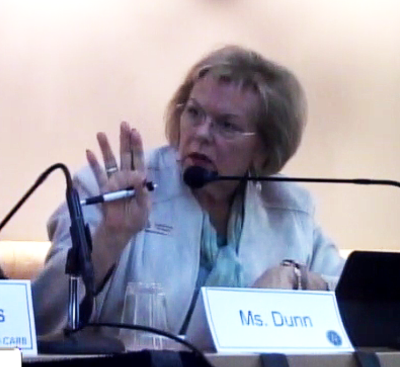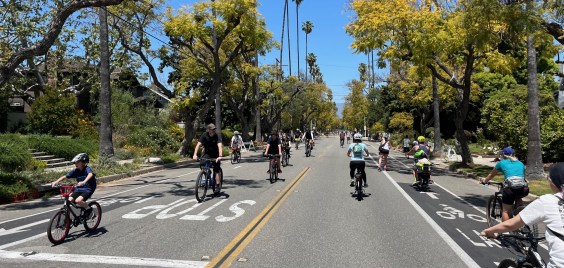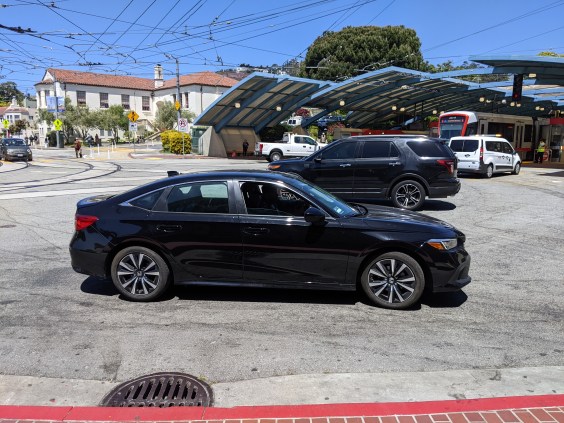Air Resources Board and Transportation Commission Meet, Again. To What Purpose?
4:52 PM PDT on April 19, 2019

Transportation Commissioner Lucy Dunn makes a point
Last week, the two California agencies in charge of air quality and transportation investments met jointly for the third time. It did not go very well--although it may not have been completely fruitless.
The California Air Resources Board (CARB) is charged with cleaning up air pollution and greenhouse gas emissions, and has power to impose and enforce regulations on industry. The agency works with local and regional air districts and the federal government on plans to reach clean air goals, and organizes and regulates the cap-and-trade system to achieve state climate goals, among other tasks.
The California Transportation Commission (CTC) allocates state funding for transportation, approving regional project lists. It writes guidelines for new programs funded by the state gas tax, following requirements set out in S.B. 1.
The two bodies almost couldn't be more different. CARB has a large staff of scientists, lawyers, and policy experts that engage in minute detail on how to achieve state clean air and climate goals. The CTC has a much smaller staff, and limits its role to guiding regions to identify priority projects, and approving funding for those projects.
And yet the two agencies are required to meet regularly to learn from each other and collaborate on ways to bring their separate goals together: that is, to find a way to invest transportation funds in a way that supports climate and clean air goals.
This is key because the transportation sector accounts for the largest share of emissions, not just greenhouse gases but also particulate and other pollutants that contribute to some parts of California having the worst air quality in the nation.
It is key because while the one agency is charged with lowering emissions, the other continues investing in a car-centric transportation system that encourages driving.
It is key because the CTC is counting on electrifying the transportation sector to solve the air quality mess, but CARB knows that will not be enough, and instead the overall amount of vehicle travel must be reduced.
It is key because the CTC vehemently rejects the notion that travel must be "curtailed" (although that's not necessarily what a reduction in vehicle travel has to mean). At the last joint meeting, the CTC rejected the conclusions of a report commissioned by the legislature that said that Californians must drive less to meet climate and air quality goals.
The CTC refused to address transportation funding at this third joint meeting. Instead, staff from the two agencies searched for a topic that could be a neutral opening for them to discuss common concerns. They came up with the future of mobility--a topic with many areas for potential discussion.
But even having an apparently neutral topic didn't help.
While acknowledging that there are fundamental differences between the two agencies and their goals, Professor Daniel Sperling of UC Davis, a member of the Air Resources Board, tried to find common ground. "I argue that the similarities are more than enough to serve as a foundation for moving forward together," he said. "We are all committed to a better transportation system--that means in the economic sense, as well as in terms of equity and the environment. We agree that we can improve our transportation system; that we can do better."
"No matter what we do about it, disruption [in the transportation sector] is going to happen," he said. "Many decisions and investments are being made, but in a very ad-hoc way, in the legislature and in state agencies" as well as in industry. "Regardless of what CARB and CTC talk about, there will be many incentive and investment programs moving forward," said Sperling.
"The heart of this discussion is not about agreeing where we're headed," he said, but "finding a way to steer innovations toward the public interest."
He outlined overarching goals "we can all agree on":
- Reducing the cost of transportation both to users and to infrastructure suppliers
- Increasing accessibility, for purposes of equity, jobs, and productivity
- Reducing fatalities and injuries
- Reducing greenhouse gas emissions and air pollution
All of these show up in various planning documents from both agencies, said Sperling. What is necessary, then, he said, is "to do a better job of aligning transportation, environmental, and health goals."
Chris Ganson from the Governor's Office of Planning and Research discussed in detail the principles his office has developed to guide state agencies as they begin to regulate and embrace automated vehicles. A panel of researchers, government officials, and advocates discussed the challenges presented by new forms of mobility, from ride-hail to scooters to electric and automated vehicles, and what is and can be done to meet those challenges. Kate Gordon, recently appointed director of the Governor's Office of Planning and Research who also serves as the governor's Senior Advisor on Climate, talked about Governor Newsom's priorities on housing, transportation, and their connections to climate and the environment.
Professor Sperling then tried to frame a conversation by asking: what are the most important strategies and actions that the CTC and CARB could focus on?
The first comment was from Commissioner Lucy Dunn, who scoffed at the notion that Mercedes Benz would "put a product on the street" if it wasn't safe. She then attacked the CARB-guided process for creating regional plans that can meet climate goals, saying "the [Sustainable Community Strategy] is a ten-year old law, and the emperor has no clothes. If it were as effective as I think it should have been, we wouldn't be in a 3.5 million home deficit, and the transportation issues that we still struggle with would be showing far better improvement," she said.
Then Dunn said that, to solve its housing crisis, the state needs to develop "principles for edge development." That is: sprawl.
It's not the first time Dunn and other members of the CTC have asserted that California cannot meet its housing needs without adding "edge development," which will increase long-distance commutes. It might be worth noting here that Dunn is the CEO of the Orange County Business Council, and fellow commissioner Fran Inman is a sprawl developer.
Commissioner Carl Guardino rejected the entire panel discussion, saying, "We have no innovators at this table. We need to show the value of having that perspective." He insisted that it was a mistake to "put thoughts on paper" without first inviting business interests to the discussion.
It may be worth noting that Carl Guardino is CEO of the Silicon Valley Leadership Group. He offered to put CARB in touch with some of the "innovators" that he thinks ought to be included in discussions of future mobility.
There was so much subtext that it was all a bit hard to keep track of. For example, Dunn made the comment about Mercedes Benz to CARB, the agency that discovered emissions testing fraud by several auto companies. This was not just accidental or incidental cheating--Volkswagen developed software that detected when a car was being tested and lowered its emission output specifically for the test. The fraud extended to the highest levels of the company.
So CARB has good reason not to trust Mercedes Benz, or any car company, to do what is right for the public good without strong, enforceable regulations.
Another subtext is a bill currently in the legislature, S.B. 59, that originally sought to enshrine the principles on automated vehicles created by OPR. The bill has since been amended and now calls for an interagency working group to create principles to guide future policy. Researchers at the University of California are also working on a somewhat expanded set of principles that encompass some of the environmental and equity aspects of the OPR's AV principles and add safety, connectivity, and other key ideas.
Meanwhile automatic vehicles are being tested on California roads now, with oversight limited to some very general rules and a requirement to submit regular crash and "incident" reports to the DMV. Tesla, for example, continuously updates its software, and an upcoming feature will allow drivers to "summon" their cars. Its autopilot functions are being "tested" in the real world by car owners.
One significant bit of subtext was the missing discussion about transportation funding priorities. Because the gas tax bill was so tricky to pass, and because it was subsequently threatened with a repeal by Prop 6, there is no appetite among members of the commission nor the legislature to revisit any of its priorities. Therefore, road widening projects that have been in the works for years will move forward, and resistance from the CTC to discuss the connection between transportation funding and climate and clean air goals will continue to sabotage the overarching goal of these joint meetings.
Other important things happened at the meeting as well. CARB chair Mary Nichols brought up the forthcoming changes to federal rules on vehicle emissions, and CTC members wanted to dwell on that topic. That, however, will have to be the subject of a future post, because it is a doozy.
The next joint meeting will happen in October, and CTC will host that one. It's very likely that at least one agenda item will be the new federal rules, which will affect planning and transportation funding throughout the entire nation. Maybe the two agencies will finally tackle the connections between transportation funding, climate, and air quality.
Which would help somewhat, because we are running out of time.
Streetsblog California editor Melanie Curry has been thinking about transportation, and how to improve conditions for bicyclists, ever since commuting to school by bike long before bike lanes were a thing. She was Managing Editor at the East Bay Express, editor of Access Magazine for the University of California Transportation Center, and earned her Masters in City Planning from UC Berkeley.
Read More:
Stay in touch
Sign up for our free newsletter
More from Streetsblog California
Active Streets Mission-to-Mission – Open Thread
Tens of thousands of participants biked, walked, skated and scootered on car-free streets through San Gabriel, South Pasadena and Alhambra
Four Things to Know About the Historic Automatic Emergency Braking Rule
The new automatic emergency braking rule is an important step forward for road safety — but don't expect it to save many lives on its own.
Supervisor Melgar Betrays Promises, Sells Out Family Killed in West Portal
Well that didn't take long
Tuesday’s Headlines
Robotaxi breaks the law, Waymo defends it; Whistleblower sues Caltrans; SANDAG gets a new leader; Zero-emission zones are helping fight pollution; More




